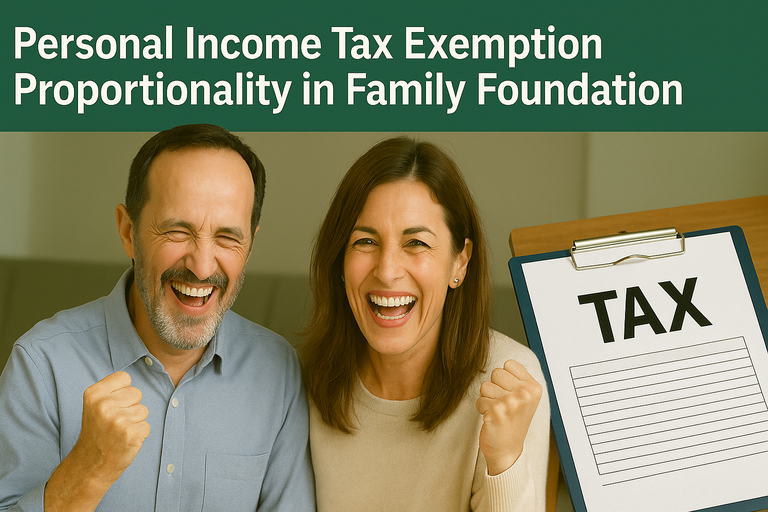
Personal Income Tax Exemption Proportionality in Family Foundation Distributions: A Comprehensive Analysis of Dual-Status Beneficiaries
The intersection of family foundation governance and personal income tax liability presents a complex nexus of statutory interpretation that merits careful examination. Of particular significance is the question of whether beneficiaries who simultaneously hold founder status and maintain qualifying familial relationships with other founders may claim complete exemption from personal income tax obligations on distributed benefits. This analysis examines the evolving jurisprudential landscape surrounding proportional exemption calculations under the Family Foundation Act, with specific attention to the administrative interpretations that have shaped contemporary practice.
Theoretical Framework: Proportional Exemption Architecture
Foundational Principles
The statutory framework governing family foundations establishes a sophisticated proportional system for determining personal income tax obligations on benefit distributions. Under Article 28 of the Family Foundation Act, the proportional value of contributed assets serves as the fundamental calculus for personal income tax liability determination. This provision creates a bifurcated classification system whereby contributed property receives differential treatment based on the identity and relationship of the contributor.
The Act delineates two distinct categories of contribution attribution: first, property contributed through donation or inheritance by the founder, or by individuals maintaining qualifying familial relationships with the founder – specifically spouses, descendants, ascendants, or siblings – shall be deemed contributed by the founder pro tanto. Second, contributions from all other parties shall be attributed to the family foundation itself, thereby affecting the proportional calculation differently.
Computational Methodology
Article 29 of the Act establishes the mathematical framework for proportional determination. The relevant proportion emerges from the relationship between the aggregate value of assets attributable to each founder or family foundation and the total value of all contributed assets. This proportional calculation directly governs the extent to which distributed benefits qualify for personal income tax exemption under the operative statutory scheme.
Exemption Analysis: The Dual-Status Beneficiary Paradigm
Statutory Exemption Provisions
Article 21(1)(157) of the Personal Income Tax Act provides the substantive exemption framework, establishing that benefits distributed from family foundations qualify for income tax exemption, subject to the aforementioned proportional limitations, in two circumstances: first, distributions to founders or qualifying family members entitled to receive property upon foundation dissolution; and second, distributions to beneficiaries who either hold founder status or maintain the requisite familial relationship with a founder.
The Convergence Question
The interpretative challenge arises when a single individual simultaneously satisfies both qualifying criteria – that is, when a beneficiary holds founder status while also maintaining a qualifying familial relationship with another founder. This dual status creates potential ambiguity regarding the appropriate application of proportional calculations.
Administrative Interpretation and Jurisprudential Development
The Full Exemption Doctrine
In a landmark individual interpretation dated March 19, 2025, the Director of the National Tax Information Service articulated what may be characterized as the “full exemption doctrine.” The interpretation (ref. 0113-KDIPT2-3.4011.134.2025.1.NM) concluded that beneficiaries who simultaneously hold founder status and qualify as family members of other founders may claim complete (100%) tax exemption on distributed benefits.
This interpretation represents a significant departure from strict proportional application, suggesting that dual-status beneficiaries occupy a privileged position within the statutory framework. The Director’s reasoning appears to rest on the convergence principle – that satisfying both qualifying criteria creates a cumulative effect rather than requiring separate proportional calculations.
Consistent Administrative Practice
The March 2025 interpretation reflects a consistent administrative approach, as evidenced by similar determinations in January 2025 (ref. 0112-KDIL2-1.4011.955.2024.1.JK) and August 2024 (ref. 0115-KDIT1.4011.415.2024.1.MR). This pattern suggests the emergence of a coherent administrative doctrine recognizing enhanced exemption rights for dual-status beneficiaries.
Limitations and Contrary Authority
The Multiple Founder Exception
However, administrative consistency encounters significant limitation in cases involving multiple founders. A May 20, 2024 interpretation (ref. 0114-KDIP3-2.4011.397.2024.1.JK2) involving four founders demonstrated the Director’s reluctance to extend full exemption principles to complex multi-founder arrangements, even where all founders maintain qualifying familial relationships.
The Director’s reasoning in this context emphasizes individual proportional calculations, explicitly rejecting the proposition that familial relationships among founders would justify treating each founder as having contributed 100% of foundation assets. This approach suggests that the full exemption doctrine may be limited to simpler founder configurations, raising questions about its broader applicability.
Implications for Foundation Planning
Risk Assessment and Compliance Strategy
The divergent administrative interpretations underscore the critical importance of individualized tax planning for family foundation structures. While the full exemption doctrine offers substantial tax advantages for dual-status beneficiaries in simple founder arrangements, the uncertainty surrounding multi-founder situations creates significant compliance risks.
Practitioners must carefully evaluate founder composition and familial relationships when advising clients on foundation structure optimization. The administrative preference for case-by-case analysis through individual interpretation requests suggests that blanket assumptions regarding exemption availability may prove problematic.
Procedural Safeguards
The Director’s interpretations consistently emphasize that tax protection depends on obtaining specific individual interpretations for particular factual circumstances. This requirement creates both opportunity and obligation for foundation planners, who must balance the costs of interpretation requests against the risks of adverse tax consequences.
Conclusion
The evolving interpretation of proportional exemption calculations in family foundation distributions reflects the inherent tension between statutory specificity and administrative flexibility. While the full exemption doctrine represents a taxpayer-favorable development for dual-status beneficiaries, its limitations in multi-founder contexts and the continuing requirement for individualized interpretations suggest that this area of law remains in active development.
Prudent foundation planning must account for both the opportunities presented by current administrative interpretations and the uncertainties that attend their application to complex family arrangements. As the jurisprudential landscape continues to evolve, practitioners would be well-advised to maintain close attention to emerging interpretative trends while ensuring comprehensive compliance through appropriate administrative guidance.

Founder and Managing Partner of Skarbiec Law Firm, recognized by Dziennik Gazeta Prawna as one of the best tax advisory firms in Poland (2023, 2024). Legal advisor with 19 years of experience, serving Forbes-listed entrepreneurs and innovative start-ups. One of the most frequently quoted experts on commercial and tax law in the Polish media, regularly publishing in Rzeczpospolita, Gazeta Wyborcza, and Dziennik Gazeta Prawna. Author of the publication “AI Decoding Satoshi Nakamoto. Artificial Intelligence on the Trail of Bitcoin’s Creator” and co-author of the award-winning book “Bezpieczeństwo współczesnej firmy” (Security of a Modern Company). LinkedIn profile: 18 500 followers, 4 million views per year. Awards: 4-time winner of the European Medal, Golden Statuette of the Polish Business Leader, title of “International Tax Planning Law Firm of the Year in Poland.” He specializes in strategic legal consulting, tax planning, and crisis management for business.



